A beautiful Friday evening at the Sultana Downrigging Weekend in Chestertown, MD. The schooner Sultana, launched in Chestertown, Maryland, in 2001, serves as an educational vessel for schoolchildren as it travels around the Chesapeake Bay. Now in its fifteenth year, Sultana’s Downrigging Weekend Tall Ship and Wooden Boat Festival has evolved into one of the largest annual Tall Ship gatherings on the East Coast.
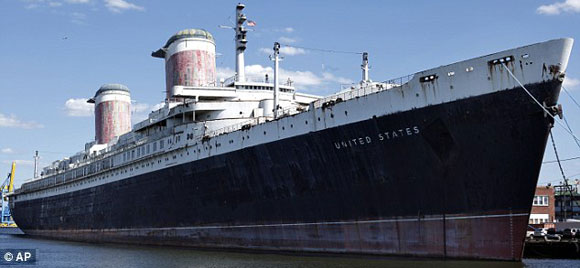 In early October, the headline in the Philadephia Inquirer was Is the S.S. United States headed toward the scrap yard?. After years of attempting to save the iconic cruise ship, the SS United States Conservancy announced that the SS United States, the fastest ocean liner ever built, might be “lost by the end of October.” The group has spent years attempting to find a developer to convert the 1951-built liner to a hotel, casino, museum, or some other form of tourist attraction. The ship has been sitting at a berth in Philadelphia for the past 19 years and is costing $60,000 per month in berthing fees. Now, a new berthing offer has emerged which may offer a reprieve for the ship.
In early October, the headline in the Philadephia Inquirer was Is the S.S. United States headed toward the scrap yard?. After years of attempting to save the iconic cruise ship, the SS United States Conservancy announced that the SS United States, the fastest ocean liner ever built, might be “lost by the end of October.” The group has spent years attempting to find a developer to convert the 1951-built liner to a hotel, casino, museum, or some other form of tourist attraction. The ship has been sitting at a berth in Philadelphia for the past 19 years and is costing $60,000 per month in berthing fees. Now, a new berthing offer has emerged which may offer a reprieve for the ship.
John Quadrozzi Jr., owner of the Gowanus Bay Terminal in the Red Hook section of Brooklyn, has offered a rent-free berth at his facility to the SS United States to allow time to work on the development plans. There are still obstacles to the plan, not the least of which is raising the estimated $2 million dollars that it would cost to tow the ship from Philadelphia.
If the ship does move to Red Hook it will be very close to its original berth on the Hudson River. As noted by New York Magazine, “This may be the first recorded case of an elderly New Yorker moving back from Philadelphia because the rent is cheaper here.“
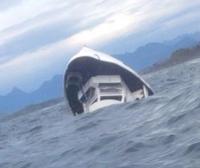
Photo: Albert Titian/Facebook
In 1998, the whale-watching boat Ocean Thunderer was hit by a wave and swamped, throwing all on board — three passengers and one boat operator — into the waters near Sea Lion Rocks, also known as Plover Reefs, off the western shore of Vancouver Island, Canada, near Tofino. The boat operator and one passenger drowned. The two other passengers were rescued, suffering from hypothermia.
Last Sunday, the whale-watching boat Leviathan II broached and capsized, throwing most of its passengers overboard near Sea Lion Rocks, not far from where Ocean Thunderer swamped seventeen years before. Five of the Leviathan II’s passengers drowned and one is still missing and presumed dead.
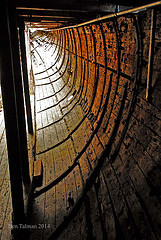
Photo: Ben Talman
Ben Talman, a reader and contributor to the Old Salt Blog, visited the Edwin Fox in Picton, New Zealand and took a series of wonderful photos of the historic ship. The Edwin Fox is an East Indiaman built in 1853 of teak in Calcutta, India. She is the second oldest surviving merchant sailing ship. Only the whaling ship Charles W. Morgan is older. To see more and larger photos of the Edwin Fox, click here.
Her career is described on the Edwin Fox Society website: On her maiden voyage to London via the Cape of Good Hope she carried 10 passengers and a general cargo. Less than a year later she was purchased by Duncan Dunbar and was immediately put into service with the British Government as a troop ship for the Crimean War, reputedly carrying such illustrious passengers as Florence Nightingale. After the fall of Sebastopol she was refitted out to again carry civilian passengers and general cargo. Edwin Fox made her first voyage to the Southern Ocean on 14 February 1856 carrying 5 passengers and some cargo arriving in Melbourne on 28th May.
Recently, we posted that five nations were responsible for 60% of the plastic dumped in the world’s oceans. Why is plastic so destructive to the ocean environment? National Geographic put together the short animation below to explain all the damage that dumping plastic can do.
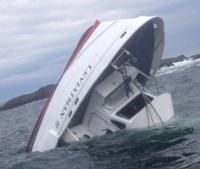
Photo: Albert Titian/Facebook
MV Leviathan II, a 65′ whale watching boat, sank late yesterday afternoon, off the port of Tofino on Vancouver Island, British Columbia, Canada. 27 were aboard when the vessel sank. Five are reported to have died and one person is still missing. Of the 21 rescued, 18 were sent to a local hospital.
Leviathan II is owned by Jamie’s Whaling Station & Adventure Centres and is one of the largest whale watching vessels in port Tofino. The boat sank near Plover Reefs, west of Vargas Island. The area is said to be a seal rookery. There is speculation that the boat hit a rock while observing seals. There are reports of a “mayday” call from the stricken vessel. The first responders on site were boats from the Ahousaht First Nation, whose members saw a distress flare. They were soon joined by local fishermen and the Canadian Coast Guard with a rescue boat and helicopter.
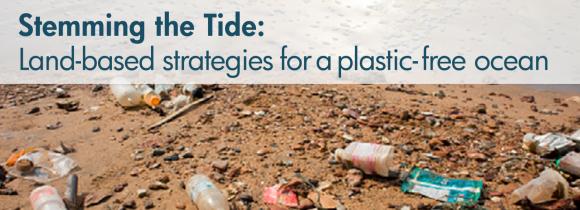 For several years now, we have posted about the so-called ocean garbage patches, the great swaths of the oceans where plastic and other floating debris accumulate while riding on vast circular currents. The problem is that an estimated 8 million metric tons of plastic are dumped into the world’s oceans each year. A new study by the Ocean Conservancy and McKinsey Center for Business and Environment, Stemming the Tide, identifies the leading plastic polluters. According to the study, five countries are responsible for 60% of the plastic dumped in the oceans — China, Indonesia, the Philippines, Thailand and Vietnam.
For several years now, we have posted about the so-called ocean garbage patches, the great swaths of the oceans where plastic and other floating debris accumulate while riding on vast circular currents. The problem is that an estimated 8 million metric tons of plastic are dumped into the world’s oceans each year. A new study by the Ocean Conservancy and McKinsey Center for Business and Environment, Stemming the Tide, identifies the leading plastic polluters. According to the study, five countries are responsible for 60% of the plastic dumped in the oceans — China, Indonesia, the Philippines, Thailand and Vietnam.
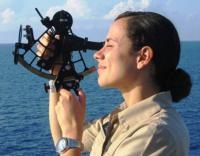 In 1998, the United States Naval Academy dropped celestial navigation from its curriculum. If a naval officer wished to know where he or she was, the officer simply had to read the display on a GPS (Global Positioning System) receiver. Sextants, chronometers, and nautical almanacs became artifacts of another, less technological time. Now, a decade and a the Navy has had second thoughts. Recent concerns about potential cyber-attacks on global positioning satellite software and data, which could disable or spoof GPS navigation systems world-wide, has led the Navy to return to teaching celestial navigation to midshipmen at the Naval Academy. Time to brush off the sextants.
In 1998, the United States Naval Academy dropped celestial navigation from its curriculum. If a naval officer wished to know where he or she was, the officer simply had to read the display on a GPS (Global Positioning System) receiver. Sextants, chronometers, and nautical almanacs became artifacts of another, less technological time. Now, a decade and a the Navy has had second thoughts. Recent concerns about potential cyber-attacks on global positioning satellite software and data, which could disable or spoof GPS navigation systems world-wide, has led the Navy to return to teaching celestial navigation to midshipmen at the Naval Academy. Time to brush off the sextants.
 When Ferdinand Magellan rounded the tip of South America in 1521, he encountered favourable winds. He named the ocean Mar Pacifico meaning “peaceful sea” in Portuguese. Today, Hurricane Patricia, the most powerful tropical cyclone ever measured in the Western Hemisphere, is expected to make landfall on the Mexican west coast near the resort cities of Puerto Vallarta and Manzanillo. This morning, the hurricane’s maximum sustained winds were measured an unprecedented 200 mph (320 kph). Weather.com reports that Hurricane Patricia now also holds the record for lowest pressure in any hurricane on record. With a minimum central pressure of 880 millibars (25.99 inches of mercury) at the 4 a.m. CDT advisory, Patricia broke the record of 882 millibars set by Wilma almost exactly 10 years ago. Perhaps, Magellan could have chosen a better name for the, so often, less than “peaceful” Pacific Ocean.
When Ferdinand Magellan rounded the tip of South America in 1521, he encountered favourable winds. He named the ocean Mar Pacifico meaning “peaceful sea” in Portuguese. Today, Hurricane Patricia, the most powerful tropical cyclone ever measured in the Western Hemisphere, is expected to make landfall on the Mexican west coast near the resort cities of Puerto Vallarta and Manzanillo. This morning, the hurricane’s maximum sustained winds were measured an unprecedented 200 mph (320 kph). Weather.com reports that Hurricane Patricia now also holds the record for lowest pressure in any hurricane on record. With a minimum central pressure of 880 millibars (25.99 inches of mercury) at the 4 a.m. CDT advisory, Patricia broke the record of 882 millibars set by Wilma almost exactly 10 years ago. Perhaps, Magellan could have chosen a better name for the, so often, less than “peaceful” Pacific Ocean.
The US Coast Guard rarely gets enough credit for the remarkable work that they do in routinely rescuing mariners in often extremely dangerous conditions. A new movie, “The Finest Hours“, is coming out this winter, which tells the story of what is considered by many to be the greatest small-boat rescue in Coast Guard history — the heroic effort to save the crew of the SS Pendleton in a horrible nor’easter off the coast of Massachusetts in 1952. Four men — coxswain Bernard C. Webber and his crew Andrew J. Fitzgerald, Richard P. Livese, and Ervin E. Mask — would later receive the Gold Lifesaving Medal, the service’s highest decoration for heroism during a rescue operation. The movie stars Chris Pine, Ben Foster and Eric Bana.
The real-life story behind Disney’s forthcoming Coast Guard rescue movie, ‘The Finest Hours’
The Finest Hours Official Trailer #1 (2015) – Chris Pine, Eric Bana Movie HD
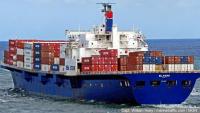 Yesterday afternoon, the National Transportation Safety Board (NTSB) released an updated report on their investigation into the sinking of El Faro in Hurricane Joaquin in early October. The report notes: “In a recorded satellite phone call to the company’s emergency call center at 7:00 am EDT, the captain told the call center operator that he had a marine emergency. He reported that there was a hull breach, a scuttle had blown open, and that there was water in hold number 3. He also said that the ship had lost its main propulsion unit and the engineers could not get it going.”
Yesterday afternoon, the National Transportation Safety Board (NTSB) released an updated report on their investigation into the sinking of El Faro in Hurricane Joaquin in early October. The report notes: “In a recorded satellite phone call to the company’s emergency call center at 7:00 am EDT, the captain told the call center operator that he had a marine emergency. He reported that there was a hull breach, a scuttle had blown open, and that there was water in hold number 3. He also said that the ship had lost its main propulsion unit and the engineers could not get it going.”
Continue reading
Happy Trafalgar Day! Today is the 210th anniversary of the overwhelming Royal Navy victory over the French and Spanish fleet off Cape Trafalgar on 21 October 1805. After considerable research, Admiral Nelson’s flagship HMS Victory has now been repainted to more accurately reflect the colors of the ship when she sailed into battle more than two centuries ago. Thanks to David Rye for contributing to this post.
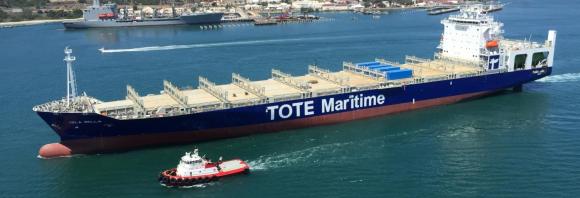
Photo : General Dynamics/NASSCO
NASSCO Shipyard in San Diego delivered Isla Bella, the world’s first LNG-powered container ship to TOTE Maritime. The 3100 TEU 764-foot long ship, the first of two 764-foot long Marlin Class container ships, should dramatically decrease emissions and increase fuel efficiency when compared to conventionally-powered ships, the equivalent of removing 15,700 automobiles from the road. The ship was delivered nearly two months ahead of schedule.
“Successfully building and delivering the world’s first LNG-powered container ship here in the United States for coastwise service demonstrates that commercial shipbuilders, and owners and operators, are leading the world in the introduction of cutting-edge, green technology in support of the Jones Act,” Kevin Graney, vice president and general manager of General Dynamics NASSCO, said in a press release. The Jones Act requires that all domestic shipping — shipping from one American port to another — be carried out by American-made and operated ships.
Isla Bella will be the newest Jones Act vessel in service. Tragically, TOTE Maritime’s El Faro, which was one of the oldest operating Jones Act ships, sank in Hurricane Joaquin, with the loss of 33 crew, on October 1.
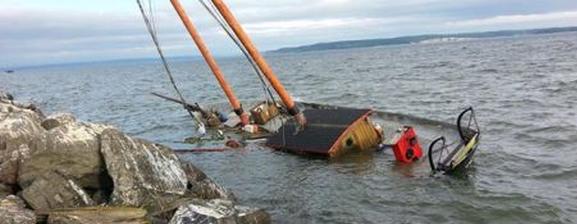 On October 9th, the schooner Phoenix dragged her anchor in a storm in Port Townsend harbor, Washington. She ended up sinking, holed on the rocks of the breakwater. The good news is that, after a week underwater, the schooner was been refloated and has been hauled out in Port Townsend. The Phoenix’s owner John Kruse is now figuring out how best to repair the schooner, including how he will finance it. He is using GiveForward.com to attempt to raise the funds to put the schooner back in service. To help out, click here.
On October 9th, the schooner Phoenix dragged her anchor in a storm in Port Townsend harbor, Washington. She ended up sinking, holed on the rocks of the breakwater. The good news is that, after a week underwater, the schooner was been refloated and has been hauled out in Port Townsend. The Phoenix’s owner John Kruse is now figuring out how best to repair the schooner, including how he will finance it. He is using GiveForward.com to attempt to raise the funds to put the schooner back in service. To help out, click here.
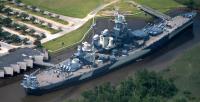
Photo: Doc Searls
The recent rain in the Carolinas has been close to unprecedented. Meteorologists have referred to it as the “1,000-year rainfall.” Another way to describe it is that it was “enough rain to float a battleship.” In this case, however, that was not a metaphor but literally what happened with the battleship USS North Carolina, which had been sitting firmly in the mud near shore on the Cape Fear River, in Wilmington, North Carolina. Flooding due to heavy rains added to the already high tides from the super blood moon eclipse resulting in an over 5-foot rise in the river, which proved enough to float the ship. The last time the battleship floated was in 2010. The river also flooded the parking lot causing the Battleship North Carolina Museum to close for several days.
Mark McCracken was out fishing for bonito half a mile off Gaviota State Beach, near Santa Barbara, when a hammerhead shark started bumping and circling his kayak. Mark, to his credit, didn’t panic, paddled toward shore and kept striking the shark with its paddle as it approached. The shark “followed me all the way into about three feet of water,” McCracken said. “Even after I got out of my kayak and made it to the beach he was sitting right there…it was pretty creepy.”
L. Francis Herreshoff was the son of naval architect, Nathanael Greene Herreshoff and the father of yacht designer and naval architect Halsey Herreshoff. L. Francis was widely respected as was a boat designer, naval architect, editor and author of books and magazine articles. Here, Doug Hylan speaks of L. Francis Herreshoff and QUIET TUNE, one of his designs.
Yacht designer Halsey Herreshoff at the Herreshoff Marine Museum in Bristol, Rhode Island, describing how his grandfather Nathanael Greene Herreshoff carved rather than drew the boats that he designed. The more interesting question may not be how Captain Nat carved the models but why. Read on after the page break.
How Herreshoff Designed His Boats
The most interesting question may be not how Nat Herreshoff designed his boats, but why carve them rather than draw lines plans? Continue reading
 When Nathanael Green Herreshoff was around 16, he began to work for his elder brother, John Brown Herreshoff, in his boat yard in Bristol, RI. To work as an apprentice was a traditional way to learn the skills and techniques to become a successful yacht or ship designer and builder. Nathanael Herreshoff took a different course, however. At 19 her went to the Massachusetts Institute of technology and earned a degree in mechanical engineering. After graduation, he took a position with the Corliss Steam Engine Company in Providence, Rhode Island and worked for the firm for eight years. At the age of 30 in 1878, Nathanael returned to Bristol and became a partner with his elder brother in the Herreshoff Manufacturing Company.
When Nathanael Green Herreshoff was around 16, he began to work for his elder brother, John Brown Herreshoff, in his boat yard in Bristol, RI. To work as an apprentice was a traditional way to learn the skills and techniques to become a successful yacht or ship designer and builder. Nathanael Herreshoff took a different course, however. At 19 her went to the Massachusetts Institute of technology and earned a degree in mechanical engineering. After graduation, he took a position with the Corliss Steam Engine Company in Providence, Rhode Island and worked for the firm for eight years. At the age of 30 in 1878, Nathanael returned to Bristol and became a partner with his elder brother in the Herreshoff Manufacturing Company.
The unusual aspect of the partnership was that while his older brother, John Brown, known in the family as J.B., was highly successful boatbuilder, he was also blind. His blindness had not prevented him from being a skilled manager and a gifted businessman. The addition of the Nathanael as a partner added a skilled designer and engineer to the firm.
 In 1859, 18 year old John Brown Herreshoff of Bristol Rhode Island, accepted his first commission to design and build a yacht. The fact that J.B., as he was known, was blind, having lost his sight at 15, didn’t seem to slow him down. He became known as the “blind boat builder.”
In 1859, 18 year old John Brown Herreshoff of Bristol Rhode Island, accepted his first commission to design and build a yacht. The fact that J.B., as he was known, was blind, having lost his sight at 15, didn’t seem to slow him down. He became known as the “blind boat builder.”
In 1863, J.B. took on space in an old tannery, hired a crew of shipwrights and established what would become the Herreshoff Manufacturing Company. In their first year, they built nine sailing craft, ranging from twenty-two to thirty-five feet long. The business continued to prosper and in 1868, the shop built its first steamer, followed by another in 1870, Seven Brothers, a pioneering fishing steamer. By 1874, J.B.’s yard had built upwards of 250 yachts and boats.
In 1878, J.B. formed a partnerships with his brother Nathanael Greene Herreshoff, seven years his junior. Together they improved the coil boiler designed by their oldest brother, James, and used the improved design in steam torpedo boats which they built for the U.S. Navy, as well as for the navies of Great Britain, Spain, Russia and Peru.
